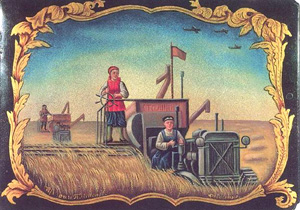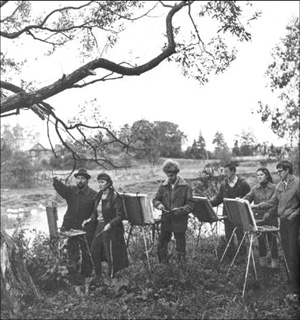The years of World War I, the Revolution of 1917 and the subsequent civil war took a heavy toll on the craftsmen and artists of Fedoskino and the lacquer workshops often stood idle as a result of raw material shortages and little demand for finished goods. This situation changed noticeably in the 1920s when Fedoskino lacquer miniatures were displayed at several international exhibitions. The beautiful lacquer paintings were regarded as a unique folk art and were discovered by the international community. Suddenly the work of the Fedoskino miniaturists was desired by collectors outside of Russia and the Russian lacquer miniature became an export commodity.
|
A group of very gifted painters from among the Vishnyakov miniaturists joined the Fedoskino Artel in 1928. Their skill, especially in painting landscapes, greatly enriched the Fedoskino craft. In order to preserve their art form, the leaders of the Artel realized that it would be necessary to recruit and train new artists for the profession. In 1933 a vocan the late 1980's as the Soviet era was coming to an end, serious changes occurred in the ideology of Russian society and in the political atmosphere. Government restrictions, that formally curbed creative freedom and prevented artists from self-expression, were lifted. At the same time, interest in Russian culture and especially the decorative and applied arts, surged around the world, giving rise to a new market for unique and expensive Russian artifacts such as the lacquer boxes of Fedoskino. (Continue to Fedoskino Today) tional school for miniature painting was opened in order to pass on the skills for creating lacquered miniatures on papier-mâché to younger generations. The school taught drawing and composition as well as the specialized skills required for miniature painting. Students were encouraged to create original compositions, and many of these paintings are the models for some of today's popular images. |
 “Reaping” – Fedoskino, 1945 Communist propaganda influenced the paintings of this era as illustrated by the work above titled "Reaping." Here the heroic workers are out in the fields as Soviet war planes fly overhead. |
 Students of the Fedoskino School - 1982 |
In the 1960's through the 1980's, the Fedoskino factory produced many boxes, mostly with Russian peasant scenes and scenes from Russian fairy tales. These boxes were sold in the government "Beryoshka" stores and were exported to the world market at relatively low prices in order to acquire hard currency. The factory, like all enterprise in Russia, was under government control resulting in a lack of incentive for creative advancement or technical perfection. The artists found little monetary reward for their efforts and most were content to turn out repetitive popular images. Despite this situation, being a lacquer miniature artist was much perferable to many of the other occupations in the USSR and the Fedoskino School of Miniature Painting had many more applications for entry than it could possibly accept.
Russian American Company 1-800-742-6228
Information about:
Lacquer Boxes Russian Dolls Russian Porcelain Russian Crystal
Faberge Jewelry Russian Christmas
